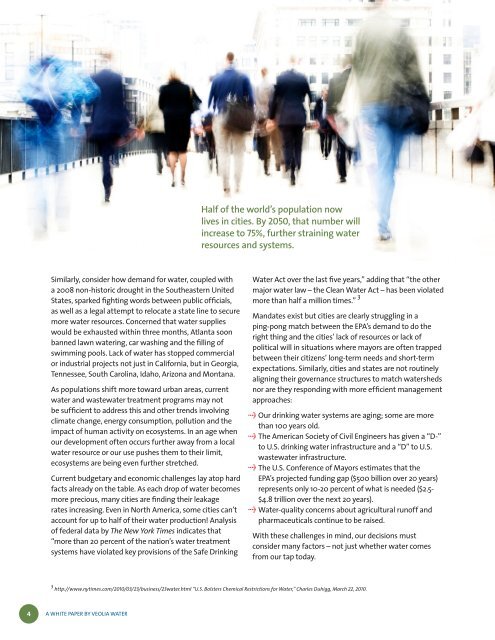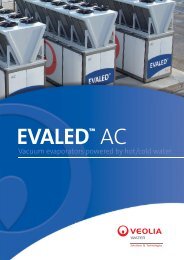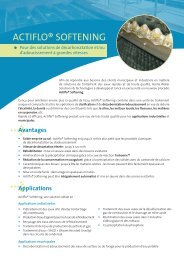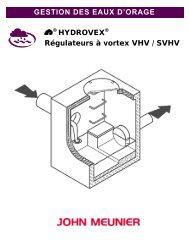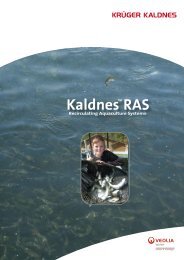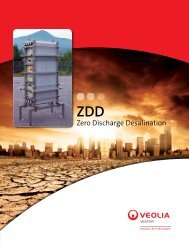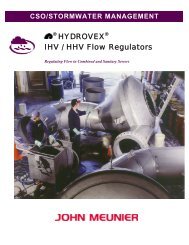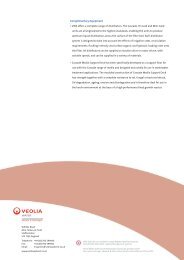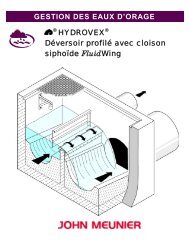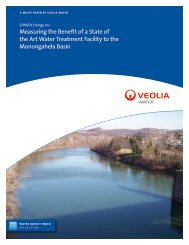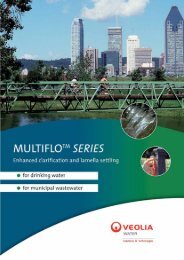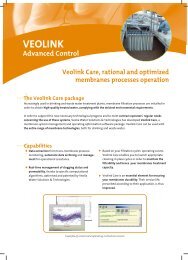Water Impact Index - Veolia Water Solutions & Technologies
Water Impact Index - Veolia Water Solutions & Technologies
Water Impact Index - Veolia Water Solutions & Technologies
You also want an ePaper? Increase the reach of your titles
YUMPU automatically turns print PDFs into web optimized ePapers that Google loves.
Half of the world’s population now<br />
lives in cities. By 2050, that number will<br />
increase to 75%, further straining water<br />
resources and systems.<br />
Similarly, consider how demand for water, coupled with<br />
a 2008 non-historic drought in the Southeastern United<br />
States, sparked fighting words between public officials,<br />
as well as a legal attempt to relocate a state line to secure<br />
more water resources. Concerned that water supplies<br />
would be exhausted within three months, Atlanta soon<br />
banned lawn watering, car washing and the filling of<br />
swimming pools. Lack of water has stopped commercial<br />
or industrial projects not just in California, but in Georgia,<br />
Tennessee, South Carolina, Idaho, Arizona and Montana.<br />
As populations shift more toward urban areas, current<br />
water and wastewater treatment programs may not<br />
be sufficient to address this and other trends involving<br />
climate change, energy consumption, pollution and the<br />
impact of human activity on ecosystems. In an age when<br />
our development often occurs further away from a local<br />
water resource or our use pushes them to their limit,<br />
ecosystems are being even further stretched.<br />
Current budgetary and economic challenges lay atop hard<br />
facts already on the table. As each drop of water becomes<br />
more precious, many cities are finding their leakage<br />
rates increasing. Even in North America, some cities can’t<br />
account for up to half of their water production! Analysis<br />
of federal data by The New York Times indicates that<br />
“more than 20 percent of the nation’s water treatment<br />
systems have violated key provisions of the Safe Drinking<br />
<strong>Water</strong> Act over the last five years,” adding that “the other<br />
major water law – the Clean <strong>Water</strong> Act – has been violated<br />
more than half a million times.” 3<br />
Mandates exist but cities are clearly struggling in a<br />
ping-pong match between the EPA’s demand to do the<br />
right thing and the cities’ lack of resources or lack of<br />
political will in situations where mayors are often trapped<br />
between their citizens’ long-term needs and short-term<br />
expectations. Similarly, cities and states are not routinely<br />
aligning their governance structures to match watersheds<br />
nor are they responding with more efficient management<br />
approaches:<br />
Our drinking water systems are aging; some are more<br />
than 100 years old.<br />
The American Society of Civil Engineers has given a “D-”<br />
to U.S. drinking water infrastructure and a “D” to U.S.<br />
wastewater infrastructure.<br />
The U.S. Conference of Mayors estimates that the<br />
EPA’s projected funding gap ($500 billion over 20 years)<br />
represents only 10-20 percent of what is needed ($2.5-<br />
$4.8 trillion over the next 20 years).<br />
<strong>Water</strong>-quality concerns about agricultural runoff and<br />
pharmaceuticals continue to be raised.<br />
With these challenges in mind, our decisions must<br />
consider many factors – not just whether water comes<br />
from our tap today.<br />
3 http://www.nytimes.com/2010/03/23/business/23water.html “U.S. Bolsters Chemical Restrictions for <strong>Water</strong>,” Charles Duhigg, March 22, 2010.<br />
4<br />
A WHITE PAPER BY VEOLIA WATER


